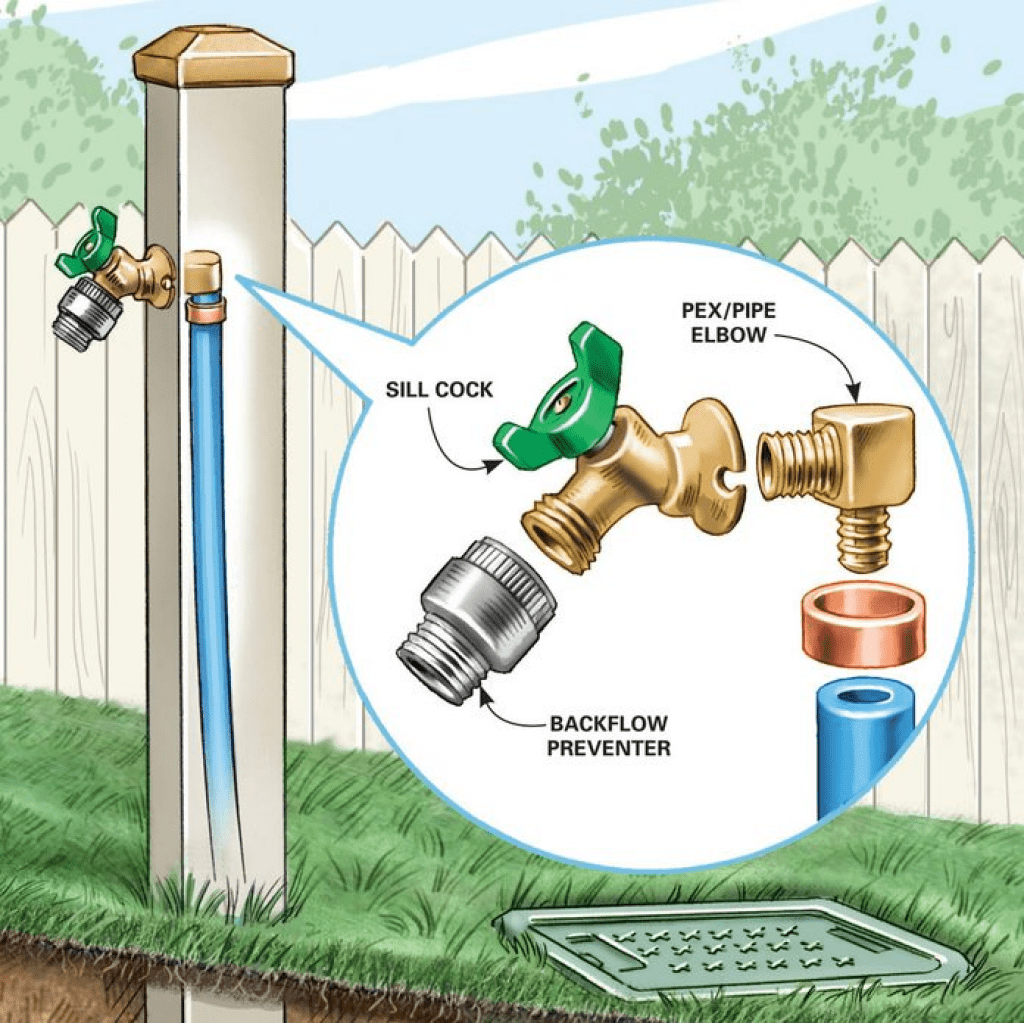How To Remove Hose From Spigot In 4 Simple Steps

If you’re wondering how to remove hose from spigot, you’ve come to the right place.
When a hose becomes stuck to your spigot, removing it can be frustrating. In some cases, significant damage can result. If your hose is stuck to the faucet during cold winters, the water in the pipes may nick the hose or even destroy the plumbing pipes.
In areas with heavy snowfall, the water in the pipes can freeze and damage the outdoor spigot for good. Fortunately, several methods remove the pesky hose from the spigot. This post will teach you how to remove hose from spigot or outdoor faucet in a short time using tools from your garage!
Keep reading to learn how professional technicians remove backflow prevention valves or valves from outdoor water lines.
What Is A Spigot Backflow Preventer?
You should know what a spigot backflow preventer is before learning how to remove hose from spigot.
A spigot backflow preventer is a small device connected to a water spigot. It is a one-way valve that holds water in the garden hose flowing in one direction – away from the water lines – but not in the opposite direction.
Some cities require them on every faucet, including garden hoses, while others do not. A backflow preventer is similar to a check valve but safer because it protects a potable water supply.
Why Did The Hose Get Stuck?
Before learning how to remove hose from spigot, let’s understand why the garden hoses get stuck on the outdoor faucet.
The most common reason that garden hoses get stuck on outdoor faucets is straightforward. Manufacturers frequently make their hose connectors using aluminum, which is why they become stuck.
However, the biggest drawback is that aluminum and brass (your faucet material) fuse when water is involved. You’re in trouble when you combine an aluminum hose connector with a brass faucet.
Now you know why your hose gets stuck on the outdoor faucet, let’s go back to your question about how to remove hose from spigot.
Here’s What You Need To Get Started
Before learning how to remove hose from spigot, let’s see what tools we need to perform the task.
Once you hold all the materials and tools, this job will take about 30 minutes. A lot will depend on how long it takes you to cut through the hose connection.
- Pair of gardening or utility gloves to protect your hands from sharp edges
- Hand drill
- Wrench (for removing the valve)
- Flathead screwdriver
- Utility knife or scissors
- We suggest this style of hose connector clamp with a female connection (made from brass or plastic).
Now that you know what tools you require to do the work let’s study how to remove hose from spigot.
You will need a drill bit, lubricant, and pressure on the set screw to perform this task. You will then be able to separate the valve from the hose spigot.
Now that you know how to remove hose from spigot, you can easily do it yourself at home without facing any trouble. Follow these simple steps mentioned above, and you’ll be able to remove that stubborn hose from the outdoor spigot.

How To Prevent Hose From Getting Stuck?
Instead of looking for answers to how to remove hose from spigot, you should learn the different methods to prevent your hose from getting stuck.
Here are three methods to prevent your hose from getting stuck in your garden:
- Remove your aluminum hose frequently. If you have aluminum water valves in your garden, remove the hose from them at least three to four times a season. Please don’t leave it on throughout the winter or during cold months.
- Avoid Aluminium Hose. If you want to eliminate the problem, don’t use an aluminum hose. It will create corrosion and fuse with your brass spigot. To completely prevent the issue, buy a hose with brass connections.
- Grease the threads with the plumber’s silicone grease. To avoid future issues with your hose, you must oil the lines of the spigot’s hose bib and the cables of the hose fitting with the plumber’s silicone grease.
All these methods will assist you in preventing your hose from getting stuck.
Common Problems Caused By Spigot Backflow Devices
Having a backflow valve on your hose is not always a good thing. Several issues can arise from installing a backflow valve on your hose. Unless you live in an area where backflow valves are required or using the hose to fill unsanitary water supplies under pressure and require potable water, you don’t need one.
Here are the common problems caused by spigot backflow devices:

- Leaks water outside: The most common problem of the valves is water leaks. You can expect leaks at both ends of the valve. Occasionally, a small trickle will occur, whereas a jet of water will sometimes shoot out the side. Because of these leaks, the garden hose loses water pressure and leaks, wasting water that runs down the ground.
- Funny sounds through house lines: One-way valves may cause a weird noise in the domestic water pipes. The sound is frequently described as vibration or hum that rings throughout the house as water flows through the pipes.
- The hose connection is not watertight: Some valves are not manufactured to create a watertight seal when a water hose is connected. This can lead to unexpected problems with leaking water and a drop in flow rate.
Keep Your Garden Hose from Freezing
You’ve gone through all the trouble of rescuing that frozen hose. So why not make sure it survives the winter? To safeguard your pipes from bursting in the winter, keep these simple maintenance tips in mind:
- Remove any attachments from your hose before the winter. To ensure your hose survives the winter, drain it of all water and let it drip out of one end.
- Drain the hose once again, and you’ll notice even more water. Reverse the pipe so the lower end is at the top and the higher end is at the bottom.
- You can use an air compressor to purge the hose’s water. Make sure the hose has no kinks and twists.
- Store your hose in an accessible location by coiling it.
- Hang your hose (with both ends facing downward) in a warm place so that it is not exposed to cold air drafts. The temperature should be at least 65 degrees.
Follow all the tricks mentioned above, and you won’t need any advice on how to remove hose from spigot because your hose will easily survive the winter without causing any trouble.

Conclusion
Removing a garden hose that has fused or become stuck on an outdoor faucet is a two-step procedure. You’ll first need to remove the hose. You’ll need to replace the hose connector on the fixture. Hopefully, this guide answers your question, “how to remove hose from spigot.”
Related Articles
Sprinkler backflow preventer leaking-how to fix?
Sump pump weep hole installation guide






